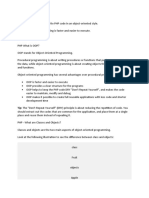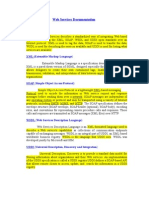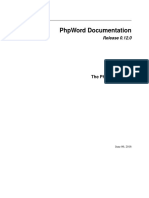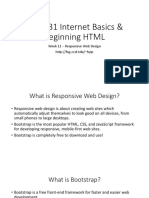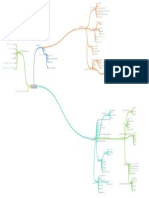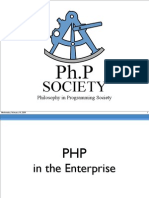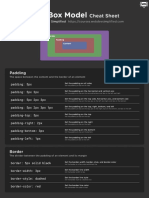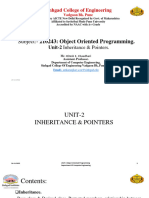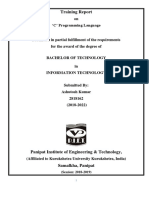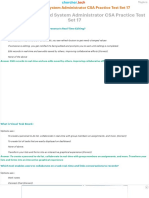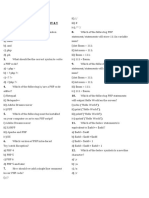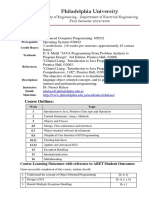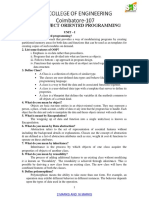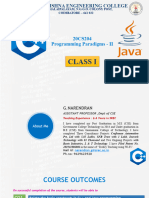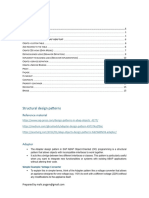Object-Oriented Programming with PHP
Methods, Classes, Objects, Abstraction Nikolay Kostov
Technical Trainer
http://nikolay.it
Telerik Software Academy
academy.telerik.com
�Summary
Classes
and objects
Methods and properties Scope Inheritance Static methods and properties Constants
Abstraction
and interfaces
�Summary (2)
Overloading Object Iteration Object Cloning Serialization Namespaces Autoloading Classes
�Classes and Objects
The idea of Object Oriented Programming is to
move the architecture of an application closer to real world
Classes are types of entities Objects are single units of a given class Example Dog is a class, your dog Lassie is an object of class Dog
Classes have methods and properties
Classes and objects help to create wellstructured application
�Classes in PHP
Declaring of a class
in PHP can be done anywhere in the code
class Dog { // declare methods and properties }
Two special methods: constructor and destructor
Executed when creating or destroying new object of this class Used to initialize or cleanup properties and etc.
�Classes in PHP
Class
definition begins with the class keyword, followed by its name and methods class name Method and properties list name
and body
class A { function foo () { new object echo Create "foo here!"; of class A } } $myFirstObject = new A(); $myFirstObject->foo(); // prints out "foo here!";
Objects of class (instances) are created with the keyword new
Execute method of this object
�Constructors
Each class
can have only one constructor
class A { function __construct ($bar) { echo $bar; } function foo () { echo "foo here!"; } } $myFirstObject = new A('test'); // print 'test'
All parameters of the creating of the object are passed to the constructor
�Properties
Class can have unlimited number of properties
class A { var $bar; function __construct ($bar) { $this->bar = $bar; } function myPrint () { echo $this->bar; } } $myFirstObject = new A('test'); $myFirstObject->myPrint();
The $this variable points to the current object called execution context
�More Properties
Class
can specify default value for a property
class A { var $bar = 'default value';
Properties
can be accessed from the outside
world
class A { var $bar = 'default value'; } $obj = new A; echo $obj->bar;
� Example of what $this
$this
is
class A { var $bar; function __construct ($bar) { $this->bar = $bar; } function myPrint () { echo $this->bar; } } $myFirstObject = new A('test'); $myFirstObject->myPrint(); // prints 'test' $anotherObject = new A('foo'); $anotherObject ->myPrint(); // prints 'foo';
Can be used to access methods too
�Destructors
Each class
can have only one destructor
Must be public
class A { function __construct ($name) { $this->fp = fopen ($name, 'r'); } function __destruct () { fclose($this->fp); } } $myFirstObject = new A('test');
Destructors are automatically called when script is shutting down
�Scope
Each method and property has a scope It defines who can access it
Three levels public, protected, private
Private can be access only by the object itself Protected can be accessed by descendant classes (see inheritance) Public can be accessed from the outside world
Level is added before function keyword or instead of var
var is old style (PHP 4) equivalent to public
Constructors always need to be public
�Scope Example
class A { private $bar; public function __construct ($bar) { $this->bar = $bar; } public The function myPrint () { so $bar variable is private echo $this->bar; only the object can access it } The myPrint method is }
public, so everyone can call it
$myFirstObject = new A('test'); $myFirstObject->myPrint(); // prints 'test' // this will not work: echo $myFirstObject->bar;
�Inheritance
A class can inherit (extend) another class It inherits all its methods and properties
class A { public $bar = 'test'; public function example () { } } class B extends A { } $obj = new B(); echo $obj->bar; //prints 'test' //calls the A-class function $obj->example();
�Protected Scope
Method or property, declared as protected can be accessed in classes that inherit it, but cannot be accessed from the outside world
class A { protected $bar = 'test'; } class B extends A { public function foo () { // this is allowed $this->bar = 'I see it'; } } $obj = new B(); echo $obj->bar; //not allowed
�Overriding
When a class
inherits another, it can declare methods that override parent class methods
Method names are the same
Parameters may differ
class A { public foo() { } } class B extends A { public foo() { } }
�Overriding Example
class A { public foo() { echo 'called from A'; } } class B extends A { public foo() { echo 'called from B'; } } $obj1 = new A(); $obj2 = new B(); $obj1->foo(); // executes A's methods $obj2->foo(); // executes B's methods
�Accessing Parent Class
As -> is
used to access object's methods and properties, the :: (double colon) is used to change scope
Scope Resolution Operator
parent::
can be used to access parent's class overridden methods
Example: call parent's constructor in the child one
�Accessing Parent Class
Example of calling
parent constructor
class A { protected $variable; public __construct() { $this->variable = 'test'; } } class B extends A { public __construct() { parent::__construct(); echo $this->variable; } } $obj1 = new B(); // prints 'test';
�The static Keyword
Defining method or property as
'static' makes them accessible without needing an instantiation of a class
Accessed with the double-colon (::) operator instead of the member (->) operator $this is not available in static methods Static properties and methods can also have scope defined public, private or protected
�The static Keyword
Example of static
method and property
class A { public static $myVariable; public static function myPrint() { echo self::$myVariable; } } A::$myVariable = 'test'; A::myPrint();
Class can access statics with the self keyword
Outside world accesses statics with the class name
�Class Constants
Constants in PHP usually are declared with the define function Constants can be defined in class Differ from normal variables no need for $ symbol to declare and access Declared with the const keyword Value must be supplied with the declaration Accessed with scope operator (::)
Can be overridden by child classes
Value must be constant expression, not a variable, class member, result of operation or function call
�Class Constants
Example of a class constant
class A { const myConstant = 'value'; public function showConstant() { echo self::myConstant; } } echo A::myConstant; $obj = new A(); $obj->showConstant();
�Abstraction
Classes, defined as abstract, cannot have instances (cannot create object of this class) Abstract class must have at least one abstract method Abstract methods do not have implementation (body) in the class
Only signature
The class must be inherited The child class must implement all abstract methods
Cannot increase visibility
�Abstraction Example
abstract class AbstractClass { abstract protected function getValue(); abstract public function getValue2($prefix); public function printOut () { echo $this->getValue(); }
} class Class1 extends AbstractClass { protected function getValue (){ return "Class1"; } public function getValue2($prefix) { return $prefix."NAC1"; } }
�Abstraction Example (2)
// continue from previous slide class Class2 extends AbstractClass { protected function getValue (){ return "Class2"; } public function getValue2($prefix) { return $prefix."NAC2"; } } $class1 = new Class1(); $class1->printOut(); // "Class1"; echo $class1->getValue2('FOO'); // FOONAC1 $class2 = new Class2(); $class2->printOut(); // "Class2"; echo $class2->getValue2('FOO'); //FOONAC2
�Interfaces
Object interfaces allow you to specify what methods a child class must implement
Declared with the interface keyword
Similar to abstract class Interface can have only public methods No method in interface can have implementation
Interfaces are inherited with the implements keyword (instead of extends) One class may implement multiple interfaces, if they do not have methods with same names
�Interface Example
interface iTemplate { public function set ($name, $value); public function getHTML($template); } class Template implements iTemplate { private $vars = array(); public function set ($name, $value) { $this->vars[$name] = $value; } public function getHTML($template) { foreach($this->vars as $name=>$value) { $template = str_replace( '{'.$name.'}', $value, $template); } return $template; } }
�Overloading
Overloading in PHP provides the means to dynamically create members and methods via set of "magical" methods
Invoked with interacting with members or methods that have not been declared or are not visible in the current scope All of the magic methods must be declared as public None of the magic functions can be called with arguments, passed by reference
�Overloading Methods
All overloading
methods are invoked when accessing variable or method that is not declared or is inaccessible $value) when writing
__set($name, __get
($name) when reading
($name) when calling isset() ($name) when calling unset()
__isset
function
__unset
function
�Overloading Methods
__call ($name, $arguments) - when calling a method
__callStatic ($name, $arguments) when calling a method in a static context
Added after PHP 5.3
Must always be declared as static
PHP "overloading" is a lot different from most languages "overloading" Usually it means the ability to declare two methods with different sets of parameters but same names
�Object Iteration
PHP provides
a way for object to be iterated trough as a list of items (array)
foreach can be used
By default iterates all visible properties
�Object Iteration Example
class A { public $var1 = 1; public $var2 = 2; protected $var3 = 3; private $var4 = 4; function printIteration () { foreach ($this as $key=>$val) echo "$key : $val\n"; } } $obj = new A(); // this prints only the public properties foreach ($obj as $key=>$val) echo "$key : $val \n"; // this prints protected and private too $obj->printIteration ();
�Object Iteration
To take object iteration a step further, you can implement one of the PHP interfaces Provided by the Standard PHP Library Allows the objects to decide what to show and what not
Some provided interfaces:
Iterator very long to implement but provides dull features
IteratorAggregate simple version of Iterator interface
ArrayIterator, DirectoryIterator, etc.
�Object Cloning
An object can be cloned with the clone
keyword
$obj1 = new A(); $obj2 = clone $obj1;
This will create new independent object
Creating
a copy of an object with fully replicated properties is not always the wanted behavior
�Object Cloning
A class can implement the magic method __clone which is called for the newly created object
Called "clone constructor"
Allows necessary changes to be done on the newly created object
Example: Object holding reference to resource the new object must have new references, instead of copies
Example: Object holding reference to another object that must not be copied
�Object Cloning Example
class A { private $fileName; private $fp = null; public function open ($file) { $this->fileName = $file; $this->fp = fopen ($file, 'r'); } public function close () { if ($this->fp) { fclose($this->fp); $this->fp = null; } } public function __clone () { // reopen the file for the new object if ($this->fp) $this->fp= fopen($this->file, 'r'); } }
�Serializing Objects
Serializing
is the process of transforming an object into a string, that can be stored
This string can be used to restore the object Useful for storing objects in session data
Saves only properties values and class names no methods
PHP provides the serialize and unserialize functions
�Serializing Objects
serialize
($object) returns string, representing the object ($string) returns new object, that is restored from the serialized string requires the class to be defined before calling it
unserialize
unserialize
�Serializing Object Example
class A { public $var; public function myPrint () { echo $this->var; } } $obj = new A; $obj->var = 10; $data = serialize ($obj); // store $data in a file file_put_contents ('data.dat', $data); // // in a new page: $data = file_get_contents ('data.dat'); $obj = unserialize ($data); $obj->myPrint (); // prints 10
�Serializing Methods
Before serializing and after unserializing PHP checks if the class has the magic methods __sleep and __wakeup
__sleep allows the class to commit pending data, cleanup or define what needs to be stored if the object is very large
Should return array with names of properties to be stored
__wakeup allows the class to restore connections or other re-initialization
�__sleep and __wakeup
class Connection { protected $link; private $server, $user, $pass, $db;
public function __construct($server, $user, $pass, $db) { $this->server = $server; $this->user = $user; $this->pass = $pass; $this->db = $db; $this->connect(); }
private function connect () { $this->link = mysql_connect ( $this->server, $this->user, $this->pass); mysql_select_db($this->db, $this->link); } // continues on next slide
�__sleep and __wakeup
// continues from previous slide public function __sleep () { // skip serializing $link return array ('server', 'user', 'pass', 'db'); } public function __wakeup () { $this->connect(); } }
�Namespaces
Namespaces in PHP are designed to resolve scope problems in large PHP libraries Simplify development in object oriented environment Clears the code no long classes names
In PHP all classes declarations are global
Namespaces allow to have two classes with same name
Old approach was adding prefixes to class names
(Like the mysql_* functions)
Available since PHP 5.3
�Namespace Definition
Namespaces are declared with the namespace keyword
Should be always in the beginning of the file
<? namespace Project;
class MyTemplate { } function print_headers () { } ?>
Namespace can contain classes, constants, functions but no free code
�Namespaces
Classes,
function and etc. in a namespace are automatically prefixed with the name of the namespace
So in the example we would use Project::MyTemplate to access the class Constants in namespaces are defined with const keyword, not with define
�Namespaces Example
// file Project.php namespace Project; // declare base classes and etc. // file project/db.php; namespace Project::DB; // declare DB interface for work with database // file project/db/mysql.php namespace Project::DB::MySQL; // implement the DB interface for mysql // file project/db/oracle.php Namespace Project::DB::Oracle; // implement the DB interface for Oracle // somewhere in the project require "project/db/mysql.php"; $a = new Project::DB::MySQL::Connection(); Project::DB::MySQL::connect();
�Using Namespaces
The use operator allows aliasing namespaces names
use Project::DB::MySQL as DBLink; $x = new DBLink::Connection(); DBLink::connect();
If new name is not specified the namespace is imported in the current context (global namespace)
use Project::DB::MySQL; $x = new MySQL::Connection(); MySQL::connect();
Even if aliased, every class and function can be accessed at any time by full name
�Global Namespace
By default PHP works in the global namespace
All the project is executed there Method from the global namespace can be referred to with empty scope operator
namespace Project::Files; // this is the Project::Files::fopen function function fopen () { $f = ::fopen (); // calls global fopen }
�Autoloading Classes
Usually every class is declared in separate file
In big object oriented projects on every page you may have to include dozens of files You can define __autoload function that is called when trying to access class that is not defined
It can include the necessary file for the class
�Autoload Example
<? function __autoload ($class_name) { $name = "includes/".$class_name.".inc.php"; if (file_exists ($name)) include $name; else echo 'Class not found'; } ?>
Exceptions, thrown in __autoload
cannot
be caught and result in fatal error
�Limitation of self::
Example:
class A { public static function whoami () { echo __CLASS__; } public static function test () { self::whoami(); } } class B extends A { public static function whoami () { echo __CLASS__; } } B::test(); // outputs 'A' ?!
�Late Static Binding
PHP 5.3 introduces the late static
binding which allows to reference the called class in context of static
In practice this adds static:: scope So if in the above example we use static::whoami() in the test() method body we get output 'B'
�Object-Oriented Programming with PHP
, SEO - , , HTML, CSS, JavaScript, Photoshop free C# book, C#, Java, C# " " " cloud "
BG Coder - - online judge , ASP.NET - , , C#, .NET, ASP.NET ASP.NET MVC HTML, SQL, C#, .NET, ASP.NET MVC , iPhone, Android, WP7, PhoneGap - - C# , ,
http://academy.telerik.com
�Exercises
1.
Define class Student that holds information about students: full name, course, specialty, university, email, phone. Define constructor for the class Student that takes full name as parameter. Add a method in the class Student for displaying all information about the student. Create two students and print their information. Create an interface IAnimal that represents an animal from the real world. Define the method talk() that prints the specific scream of the animal ("jaff" for dogs, "muaw" for cats, etc.).
2.
3.
4. 5.
�Exercises (2)
6.
Create an abstract class Cat that has Name and implements the interface IAnimal and introduces abstract method printInfo(). Inherit from the base abstract class Cat and create subclasses Kitten and Tomcat. These classes should fully implement the IAnimal interface and define an implementation for the abstract methods from the class Cat. Create class Dog that implements IAnimal.
7.
8. 9.
Write a class TestAnimals that creates an array of animals: Tomcat, Kitten, Dog and calls their methods through IAnimal interface to ensure the classes are implemented correctly.
�Exercises (3)
10.
We are given a school. In the school there are classes of students. Each class has a set of teachers. Each teacher teaches a set of disciplines. Students have name and unique class number. Classes have unique text identifier. Teachers have name and title. Disciplines have name, number of lectures and number of exercises.
Define classes for the school (School, Class, Student, Teacher, Discipline). Keep the member fields private. Add constructors and accessor methods. Write a testing class to construct and print a sample school.
�Exercises (4)
11.
We need to implement a message board where visitor can read all messages, add new messages, edit and delete existing messages.
Implement this as a PHP application by following the steps below:
Create a MySQL database Messages and define in it a table messages(id, author, subject, msgDate, msgBody). Write a class Message which will hold a single message with its id, author, subject, msgDate and msgBody. Put this class in the file message.class.php.
�Exercises (5)
Write a class DBUtils which will be responsible for database access for the entire application. Put this class in the file db-utils.class.php. Implement the following methods:
dbConnect() connects to the MySQL database and selects Messages database getAllMessages() returns an array of Message objects containing all messages from the database addMessage($msg) inserts a message given as Message object to the database
updateMessage($msg) updates a message given as Message object in the database
deleteMessageById($msg_id)- deletes given message specified by its primary key
�Exercises (6)
Write a PHP script index.php which displays all messages in a table.
Implement a form for adding a message as separate script add-message.php.
Implement deleting of a message by clicking a hyperlink in the corresponding row in the table. Implement it as separate script delete.php. Implement editing of a message by clicking on a hyperlink in the corresponding row in a table. Implement it as separate script edit-message.php.
�Free Trainings @ Telerik Academy
PHP & MySQL Web Design" course
academy.telerik.com/.../php-schoolacademy-meeting
Telerik Software Academy
academy.telerik.com
Telerik Academy @ Facebook
facebook.com/TelerikAcademy
Telerik Software Academy Forums
forums.academy.telerik.com
